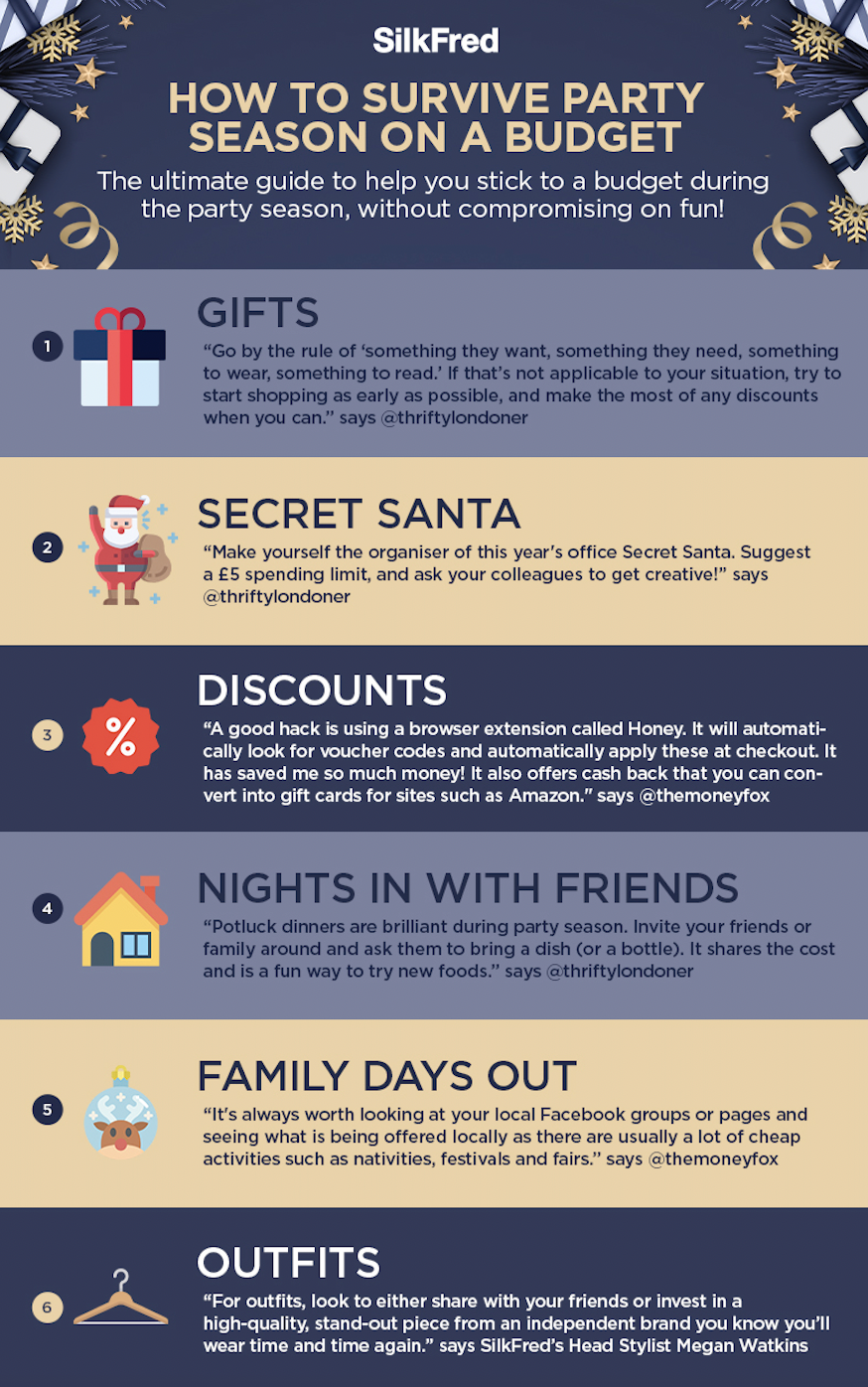How to survive party season on a budget

The Christmas adverts are here, there’s a chill in the air and we can almost smell the mulled wine and mince pies. And yes, that is the first christmas party e-invite in your inbox.
Whilst we can’t wait to break out our sparkly dresses, drink copious amounts of fizz and say yes to every Christmas event invite going, we can’t help wondering, how much is this all going to cost?
With the cost of living crisis seeing six in 10 UK adults finding it hard to keep up with their bills, coupled with the fact that the hashtag #moneysavingtips is currently at 693.6m views on TikTok, it’s no surprise that more and more people are on the lookout for the all important money saving tricks this festive season.
Luckily, the online destination for independent fashion brands, SilkFred has teamed up with Instagram’s favourite money saving experts to bring you the ultimate party season survival guide. From Christmas presents for the kids, to how to save money on those ever-more-expensive train tickets, this budgeting guide will help you become the most prepared and the most under-budget guest this party season.
Source: Canva
1. Gifts
Christmas is all about giving unique gifts that you definitely haven’t panic-bought on Christmas Eve. Presents often take up alot of our budget, and could be why we spend on average almost £740 more in December, which is 29% more than in a typical month.
Money blogger Laura, who runs the popular personal finance Instagram account @thriftylondoner recommends: “For the little ones, go by the rule of ‘something they want, something they need, something to wear, something to read.’ It helps to keep you on budget and stops your home from becoming cluttered! If that’s not applicable to your family situation, try to start shopping as early as possible, and make the most of any discounts when you can.”
Source: Canva
2. Secret Santa hack
When it comes to office gifting, Laura suggests: “If it’s not already been decided, make yourself the organiser of this year’s office Secret Santa. Suggest a £5 spending limit, and ask your colleagues to get creative!”
Source: Canva
3. Discounts
When it comes to finding a bargain during the festive period, Francesca (@the.moneyfox) says: “One of my best hacks is using a browser extension called Honey. It will automatically look for, and apply any voucher codes that it can find. It has saved me so much money! As well as saving you money, it also offers cash back which you can convert into gift cards for sites such as Amazon.”
Source: Canva
4. Going out
December is party season for a reason, with everyone wanting to celebrate and let off some steam. However, attending events, keeping the kids entertained in the school break and even organising your own Christmas party can be extremely costly.
When hosting your own events, Laura of @thriftylondoner suggests: “Potluck dinners are brilliant. Invite your friends or family around and ask them to bring a dish (or a bottle). It shares the cost and is a fun way to try new foods.”
Need to keep the kids occupied during Christmas break? Francesca (@the.moneyfox) suggests: “It’s always worth looking at your local Facebook groups or pages and seeing what is being offered locally as there are usually a lot of cheap activities such as nativities, festivals and fairs.”
Source: SilkFred
5. Outfits
Christmas fashion is all about sparkle, jewel tones and those novel festive jumpers you keep at the back of your wardrobe.. With every event requiring a slightly different style, finding outfits that fit every dress code can start to become very expensive.
Megan Watkins, head stylist at SilkFred, suggests: “When trying to save on party outfits, there are a couple tried and true options to keep you on budget:
Share – setting up a swapping system with your stylish mates is basically like getting another wardrobe for free! Our engaged Facebook group is also a hub of information, whether you want to re-sell, buy used or just find a review before you make the purchase.
Tailoring – have an old party season outfit you know you could wear again but something isn’t *quite* right? Try taking it to your local tailors who could shorten it, remove the sleeves or add an added element from as little as £8!
Invest in timeliness items – If you are wanting a new party look, be sure to invest in a style you can wear time and time again. Do NOT be afraid to outfit repeat, it’s all about getting the wear out of an outfit you love.






